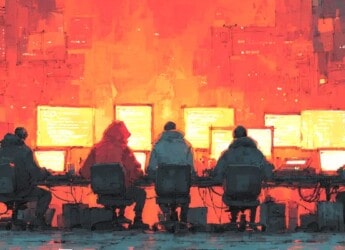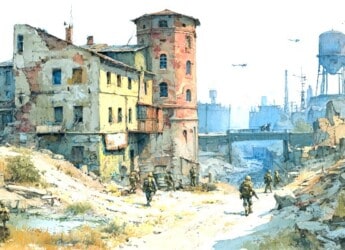Editor’s Note: The November 7–8 strikes across Ukraine marked one of the heaviest Russian aerial assaults of 2025. Drawing from battlefield assessments from the Institute for the Study of War (ISW), this article details how Russia coordinated more than 500 drone and missile strikes against Ukrainian thermal plants, substations, and rail junctions, while Ukraine responded with targeted attacks on Russian energy infrastructure in Saratov and Volgograd Oblasts.
While grounded in conventional warfare, the effects of these operations resemble those of cyber-physical disruptions—where degraded visibility, disrupted mobility, and operational strain place critical systems under pressure. For professionals focused on cybersecurity, information governance, and eDiscovery, the report underscores how infrastructure disruption can impact continuity, evidence preservation, and system reliability across both digital and physical domains.
This reporting extends battlefield coverage to highlight the operational importance of infrastructure under persistent threat. As winter demand intensifies, the resilience of power, transport, and communications systems is no longer a supporting issue—it is a core operational factor shaping frontline outcomes.
For those seeking to grasp the full scope of this evolving landscape, the Institute for the Study of War’s comprehensive updates serve as an invaluable resource.
Content Assessment: Infrastructure Strike Escalation: Ukraine and Russia Trade Blows Across Critical Nodes
Information - 94%
Insight - 92%
Relevance - 90%
Objectivity - 90%
Authority - 94%
92%
Excellent
A short percentage-based assessment of the qualitative benefit expressed as a percentage of positive reception of the recent article from ComplexDiscovery OÜ titled, "Infrastructure Strike Escalation: Ukraine and Russia Trade Blows Across Critical Nodes."
Background Note: ComplexDiscovery’s staff offers distinctive perspectives on the Russo-Ukrainian war and Middle Eastern conflicts, informed by their military experience on the West German, East German, and Czechoslovakian borders during the Cold War, as well as in Sinai as part of Camp David Accord compliance activities, during the timeframe of the Persian Gulf War. This firsthand regional knowledge has been further enhanced by recent staff travels to Eastern European countries, including Estonia, Finland, Latvia, Lithuania, and Poland. These visits have provided up-to-date, on-the-ground insights into the current geopolitical climate in regions directly impacted by the ongoing conflict.
Combined with cybersecurity, information governance, and eDiscovery proficiency, this multifaceted experience enables comprehensive analysis of these conflicts, including the critical impact of cyber warfare, disinformation, and digital forensics on modern military engagements. This unique background positions ComplexDiscovery to provide valuable insights for conflict-related investigations and litigation, where understanding the interplay of technology, data, and geopolitical factors is crucial.
Russo-Ukrainian Conflict Update*
Infrastructure Strike Escalation: Ukraine and Russia Trade Blows Across Critical Nodes
ComplexDiscovery Staff
In the cold hours of November 7–8, a sky crowded by engines and contrails set the day’s terms before dawn. Russia launched a massive package of more than five hundred drones and missiles against Ukraine, one of the heaviest overnight strike packages documented in 2025. Ukrainian air defenses reported intercepting the majority, yet dozens of weapons reached energy and industrial targets, lighting thermal plants and substation yards and forcing operators to triage systems in real time. The strikes arrived as temperatures fall and electricity demand rises, turning kilowatts into a battlefield commodity and pushing Ukraine’s grid managers into a nightly test of resilience.
The most visible consequences came at two state-owned thermal plants, where operators reported halted output after repeated impacts. Those facilities had been significant contributors to national generation and had undergone substantial repairs after 2024 attacks. Fires and outages rippled outward as responders worked to contain blazes, restore feeders, and reroute supply. The rail network felt the shock as well: Ukraine’s railway operator disclosed delays in Poltava Oblast, while geolocated footage showed a key depot at Hrebinka damaged—a junction linking Kyiv and Poltava and part of a wider lattice feeding the eastern theater. The pattern, while familiar, has sharpened: deep-strike rail targeting and power-system pressure working in tandem to compress Ukraine’s mobility and industry.
Ukraine answered with cross-border strikes against Russian energy nodes. Explosions near the Saratov Oil Refinery and at the Baloshovskaya substation in Volgograd Oblast—part of a grid path connecting the Volga hydropower asset to central regions—signaled a reciprocal strategy aimed at complicating Russian refiners and transmission corridors. Regional officials in Russia reported temporary outages and damage assessments in several oblasts. While these actions did not appear to produce long-term blackouts, they highlighted an expanding contest over the infrastructure that sustains artillery, armor, and winter heating alike.
Against this backdrop, the ground fight near Pokrovsk entered a period of measured movement. Russian forces notched only a small gain into northern Myrnohrad, a shift far more modest than advances seen earlier in the week. Russian military channels claimed progress near Rivne along the T-0515 road and in Krasnyi Lyman to the northeast. Still, Ukrainian observers described the urban area of Pokrovsk as a patchwork of contested city blocks. Reports indicated Russian forward elements in the north and a larger grouping positioned in the south, while small assault teams probed toward the T-0515 corridor under heavy Ukrainian drone pressure. Ukrainian officials said logistics north of the city had been partially restored, allowing ammunition to move into urban positions. These reports suggest Russia is fortifying and moving reinforcements while trying to build supply lines for another push, and Ukraine is using drones and counterattacks to disrupt that assembly.
Further north, fighting in Sumy Oblast continued without recorded territorial change. A Russian servicemember’s account, amplified by a blogger linked to the Northern Grouping of Forces, described heavy losses near Bezsalivka, desertions, communications gaps, and resupply complications due to Ukrainian drones. Russian concentrations near Kindrativka suggested preparation for a larger effort, but the feasibility of such a move under persistent unmanned attacks remained uncertain. Elements reportedly present included the 217th Airborne Regiment and drone operators from the 30th Motorized Rifle Regiment, indicating a mix of light infantry and UAV teams tasked with suppressing Ukrainian positions.
East of Kharkiv City, engagements persisted around Vovchansk, Synelnykove, and nearby settlements. One Russian source claimed Ukraine now holds only a small portion of Vovchansk, while independent geolocation indicates Russian control of roughly a third of the city, leaving room for close-quarters battles to continue. Along the Kupyansk–Lyman belt, Russian forces struck near Petropavlivka, Pishchane, Torske, and Yampil, and a Ukrainian infiltration in southern Kupyansk reportedly hit a Russian-occupied building without changing the forward line. Identified formations included the 68th Motorized Rifle Division, elements of the 1st Guards Tank Army, and the 144th and 3rd Motorized Rifle Divisions, an order of battle consistent with sustained pressure across the sector.
Southward, the Siversk and Kostyantynivka–Druzhkivka areas saw continued Russian assaults on multiple approaches. A fiber-optic guided drone attack struck a marked humanitarian vehicle at the entrance to Kostyantynivka; all four occupants survived, while separate first-person-view strikes injured civilians. In the Dobropillya area, Russian claims of advances near a quarry by Toretske remained unconfirmed amid reports that Ukrainian defenses pushed Russian units back toward a defensive line from Hruzke through Shakhove and Sofiivka. The day was defined less by large map changes than by attrition, short thrusts, and the search for weak seams.
Along the southern axis, Russian forces pressed near Novopavlivka and explored avenues toward Velykomykhailivka, with official claims of a seizure at Vovche and geolocated evidence that refined earlier assessments in Oleksiivka. In the Hulyaipole sector, a blogger asserted movement to the edges of Solodke, Nove, and Novouspenivske, while units of the 218th Tank Regiment were tied to the prior capture of Uspenivka. Western Zaporizhia saw attacks near Mala Tokmachka and along the shoreline communities of the former reservoir west of Orikhiv. One Russian account downplayed operations in the drained basin, yet Ukraine’s Southern Command described Russian use of dense vegetation near Prymorske to mask approaches. On the Kherson front, limited ground actions continued along the east bank, including toward the Antonivskyi roadway bridge, as fog reportedly constrained Ukrainian drone operations.
Two leadership moves added weight to the day’s operational picture. In Moscow, Colonel General Alexander Sanchik, most recently commanding the Southern Military District after prior service with the 35th Combined Arms Army, was appointed Deputy Defense Minister for Logistics, replacing Andrei Bulyga. Russian commentators expressed hope that field command experience could translate into stronger materiel flow, even without a logistics-specialist background. In Kyiv, President Volodymyr Zelensky named Colonel Yuriy Cherevashenko to command the Unmanned Air Defense Systems service, a formation announced in late September to deploy interceptor drones against Shahed-type systems and integrate new tools with existing air defenses. The precise command relationship with ground forces’ organic air defenses remains to be clarified, but the appointment signals a push to scale counter-UAS capacity ahead of winter.
Beyond Ukraine’s borders, Belarusian media displayed a T-72 fitted with improvised cage armor over the turret and hull, mirroring Russian adaptations to counter top-attack munitions and FPV threats—another sign of the gradual absorption of frontline lessons. In Crimea, Ukraine’s Special Operations Forces reported a prior October 6 operation against an ammunition depot of the 18th Combined Arms Army and an S-400 system, an example of continued precision activity against rear-area enablers.
Taken together, November 8 featured a rebalanced fight: a slowed pace around Pokrovsk while Russia applied pressure through the air, Ukraine stressed Russian energy and grid nodes in reply, and both capitals appointed commanders to strengthen logistics and unmanned defense. The contest now hinges on whether air defense integration and rail protection can absorb further waves while ground forces either regain momentum or harden lines. As winter demand rises and ammunition flows decide local battles, the strategic question is direct: can infrastructure protection and counter-drone scaling blunt the next combined push before power scarcity and supply friction reshape the front?
Assessed Control of Terrain Map for November 8, 2025
Russo-Ukrainian-War-November-8-2025About the Institute for the Study of War Research Methodology
ISW’s research methodology relies on both primary and secondary sources, enabling researchers to develop a comprehensive understanding of the situation on the ground. In order to analyze military and political developments in any given area, ISW’s research analysts must wholly understand the systems of enemy and friendly forces. They must also understand the population demographics, physical terrain, politics, and history of that area. This lays the analytical foundation for understanding the reasons for particular developments and fulfilling their assigned research objectives. ISW analysts also spend time in places like Iraq, Afghanistan, and elsewhere in order to gain a better understanding of the security and political situation and to evaluate the implementation of current strategies and policies. Their researchers compile data and analyze trends, producing a granular analysis of developments in areas of research, producing an accurate, high-resolution, timely, and thorough picture of the situation. ISW’s research methodology guarantees its success and commitment to improving the nation’s ability to execute military operations, achieve strategic objectives, and respond to emerging problems that may require the use of American military power.
About the Institute for the Study of War
The Institute for the Study of War advances an informed understanding of military affairs through reliable research, trusted analysis, and innovative education. They are committed to improving the nation’s ability to execute military operations and respond to emerging threats in order to achieve U.S. strategic objectives. ISW is a non-partisan, non-profit, public policy research organization.
Learn more, get involved, and contribute today.
News Source
- Russian Offensive Campaign Assessment, November 8, 2025 (Institute for the Study of War)
Assisted by GAI and LLM Technologies
* Sourced and shared with permission from the Institute for the Study of War (ISW).
Additional Reading
- From Dissent to OSINT? Understanding, Influencing, and Protecting Roles, Reputation, and Revenue
- Data Embassies: Sovereignty, Security, and Continuity for Nation-States
Source: ComplexDiscovery OÜ


























